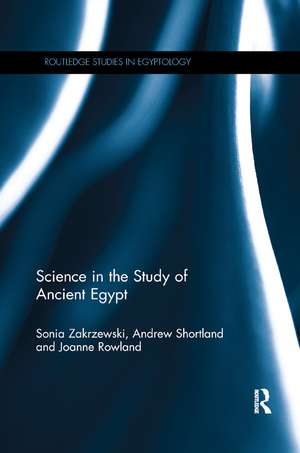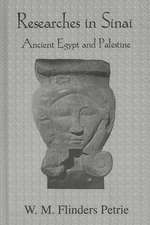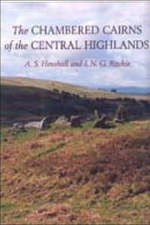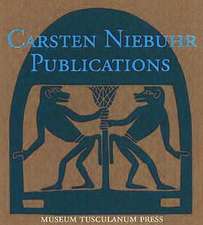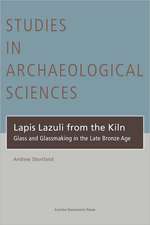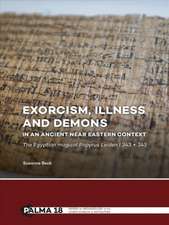Science in the Study of Ancient Egypt: Routledge Studies in Egyptology
Autor Sonia Zakrzewski, Andrew Shortland, Joanne Rowlanden Limba Engleză Paperback – 10 dec 2019
Using a range of case studies which exemplify best practice within Egyptian archaeological science, Science in the Study of Ancient Egypt presents both the scientific methods of analysis available and their potential applications to Egyptologists. Although Egyptology has mainly shown a marked lack of engagement with recent archaeological science, the authors illustrate the inclusive but varied nature of the scientific archaeology which is now being undertaken, demonstrating how new analytical techniques can develop greater understanding of Egyptian data.
| Toate formatele și edițiile | Preț | Express |
|---|---|---|
| Paperback (1) | 384.86 lei 6-8 săpt. | |
| Taylor & Francis – 10 dec 2019 | 384.86 lei 6-8 săpt. | |
| Hardback (1) | 1064.67 lei 6-8 săpt. | |
| Taylor & Francis – 10 dec 2015 | 1064.67 lei 6-8 săpt. |
Preț: 384.86 lei
Nou
Puncte Express: 577
Preț estimativ în valută:
73.65€ • 77.44$ • 60.85£
73.65€ • 77.44$ • 60.85£
Carte tipărită la comandă
Livrare economică 17 aprilie-01 mai
Preluare comenzi: 021 569.72.76
Specificații
ISBN-13: 9780367865634
ISBN-10: 0367865637
Pagini: 426
Dimensiuni: 152 x 229 x 18 mm
Greutate: 0.34 kg
Ediția:1
Editura: Taylor & Francis
Colecția Routledge
Seria Routledge Studies in Egyptology
Locul publicării:Oxford, United Kingdom
ISBN-10: 0367865637
Pagini: 426
Dimensiuni: 152 x 229 x 18 mm
Greutate: 0.34 kg
Ediția:1
Editura: Taylor & Francis
Colecția Routledge
Seria Routledge Studies in Egyptology
Locul publicării:Oxford, United Kingdom
Public țintă
Postgraduate and UndergraduateCuprins
@contents:Introduction Part I: The Biography of Time and Space 1. Time and Dating 2. Finding Sites 3. Topographic Survey 4. Environment and Palaeoenvironment 5. Spatial and Chronological Organization of Burial Grounds Part II: The Biography of People 6. Death and Burial 7. Activity and Occupation 8. Health and Disease 9. Diet and Subsistence 10. Clothing and Adornment 11. Migration and Mobility 12. Social Organization and Status Part III: The Biography of an Object 13. Raw Materials 14. Production 15. Distribution and Consumption 16. Deposition and Taphonomy 17. Reconstruction and Display Conclusion Glossary Methods Appendix
Notă biografică
Sonia Zakrzewski is a Lecturer in Archaeology at the University of Southampton. She publishes widely in physical anthropology and science journals and has edited two books.
Andrew Shortland is the Director and Senior Lecturer of the Centre for Archaeological and Forensic Analysis at Cranfield University, where he runs a group that specializes in the application of scientific techniques to archaeological and forensic problems. He publishes widely in archaeological and science journals and has written two books and edited two more.
Joanne Rowland is a researcher in the Egyptian Collection at the Royal Museums of Art and History, Brussels and a Research Fellow in Egyptology and Archaeological Science at the Research Laboratory for Archaeology and History of Art (RLAHA) at Oxford University. She publishes widely in Egyptology and archaeological science, and has aided in the editing of several Egyptian archaeology volumes.
Andrew Shortland is the Director and Senior Lecturer of the Centre for Archaeological and Forensic Analysis at Cranfield University, where he runs a group that specializes in the application of scientific techniques to archaeological and forensic problems. He publishes widely in archaeological and science journals and has written two books and edited two more.
Joanne Rowland is a researcher in the Egyptian Collection at the Royal Museums of Art and History, Brussels and a Research Fellow in Egyptology and Archaeological Science at the Research Laboratory for Archaeology and History of Art (RLAHA) at Oxford University. She publishes widely in Egyptology and archaeological science, and has aided in the editing of several Egyptian archaeology volumes.
Descriere
Science in the Study of Ancient Egypt demonstrates how to integrate scientific methodologies into Egyptology broadly, and in Egyptian archaeology in particular, in order to maximise the amount of information that might be obtained within a study of ancient Egypt, be it field, museum, or laboratory-based. The authors illustrate the inclu
